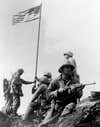Gun History: M-1 Carbine—The Gun that Got Above Its Pay Grade
We may earn revenue from the products available on this page and participate in affiliate programs. Learn more › To...

We may earn revenue from the products available on this page and participate in affiliate programs. Learn more ›

To understand the United States Carbine, Caliber .30, M-1, it’s helpful to recount the experience of my Uncle Ed who was a naval officer in World War II. In the course of his training he was expected to qualify with the Model 1911 Colt by standing 25 yards from a bull’s-eye target, assuming a duelist’s stance, firing 10 rounds, and getting a score of at least 70 out of 100. Uncle Ed, whose prior experience with handguns was nil, did not get a shot on the paper. The range officer who scored his target took out a fountain pen, punched ten holes in the black, and said, “Congratulations, Ensign, you’ve just qualified with the .45.” Uncle Ed, who was a thoughtful type, then bought a Colt .38 Special revolver which he carried throughout the war.
My uncle’s experience was common. The Model 1911, despite its awesome virtues, was not an easy pistol to master, and its range, even in the best of hands, was limited. The Army, in particular, knew that it needed a defensive weapon for troops whose primary job was not shooting at people. Armor, Artillery, Military Police, Signal Corps, Transport and other personnel whose assignment was not to ventilate people in mustard-colored and gray uniforms, but who might need to defend themselves, found the Garand an encumbrance, and the Tommygun far too heavy. The Model 1911 was highly effective inside 10 feet, but if you were getting shot at from farther than that, you were in trouble.

And so, in October of 1941, the Army approved the design of a lightweight carbine. Contrary to myth, the new gun was not designed by Carbine Williams while he was in prison. Williams did create the short-stroke gas piston system used in the weapon, but the design of the weapon itself was the work of Winchester engineers.
The M-1 Carbine was truly short and light. Empty, it weighed just over 5 pounds (half the weight of a Garand). The barrel was only 18 inches long, and the gun fed from a 15-round box magazine, which was later increased to 30 rounds (pictured above). The cartridge chosen was a rimless version of the old .32 Winchester Self-Loading round. In the 18-inch barrel, it propelled a 110-grain bullet at 1,970 fps. The .30 Carbine was anemic, but it could hit at 200 yards, and anyway, it was for emergency use only.

The original M-1 Carbine was semi-auto only, but it was joined before war’s end by the M-2, which was semi- or full-auto, and by a collapsible-stock version for paratroopers (above). Just about every combat carbine I’ve ever seen wore a two-magazine (15-round variety) pouch on its buttstock as the ultimate fashion statement (below).
Soldiers loved the little gun. It was light, handy, had hardly any recoil, and saved you the trouble of carrying a real gun. It became–and this was a shock to me–the most-produced American infantry rifle of World War II. At 6.5 million, it beat out the Garand by 500,000–all in all, a huge success. But then troubling reports started coming back from the front. These are best summarized by the experience of an infantryman I knew when I was a kid who fought in the Battle of the Bulge, and whose narrative I’m reproducing here after over 50 years.

“Our platoon was charged by a unit of SS troops, but we put enough rifle fire into them so they changed their minds, and as they ran the other way, I put my Carbine sights on one great big bastard who was wearing a filthy greatcoat. I squeezed off all 15 rounds, and I hit him with every one, because I could see the puffs of dirt fly off his coat. As I was reloading, he finally fell down. I threw that goddamn Carbine away and picked up a BAR, which I used the rest of the war.”
The .30 Carbine round was lacking–badly. But overall, for what it was, the little rifle gave good service. Then came Korea, and in the dreadful cold of the winter of 1950-51, the Carbine met its match. Its small bullet and low velocity could not put down Chinese and North Korean troops wearing heavily quilted uniforms. The gun themselves jammed frequently, and the stocks broke.
The Carbine went on the services’ “to replace” list. Good looks and a charming personality were not enough. Even so, the M-1 and M-2 stuck around, and were used in the early stages of Vietnam before they were phased out for the M-16. So useful was the weapon that it remained on our roster of equipment until 1973. Millions were sold by our government to the armies of other nations, and the Carbine is still in use by obscure police forces and sinister indigenous personnel who can’t get an AK-47.
A great many semi-auto M-1 carbines (and a number of M-2s, kind of secretly) made their way into the civilian market here, and people insisted on hunting with them, despite the fact that the .30 Carbine round is no more suited to big game than it is to SS troopers. If you have a Carbine, it is strictly a plinker.
It is also a piece of history, one of the guns that won World War II. It is by no means perfect, but it deserves our interest and our respect nonetheless.
